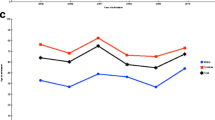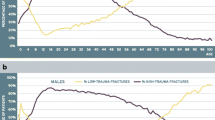Abstract
Introduction
Multiple fractures are of high clinical relevance, as a significant increase in mortality rate has been described. The purpose of this study was to evaluate differences in age and gender distribution in multiple fractures dependent on severity of trauma. Furthermore, affected anatomic regions and frequently associated fracture regions were investigated.
Methods
Patients who had sustained multiple fractures between 2000 and 2012 were included in this study. At hospital admission, patients were divided according to trauma severity (high- vs low-traumatic), gender, and age for demographic analysis. Fractures were grouped in anatomical regions, and multiple fracture event probabilities as well as frequently associated regions were calculated.
Results
In total, 25,043 patients at an age range of 0–100 years (5.8% of all fracture patients; 14,769 male and 10,274 female patients) who sustained 57,862 multiple fractures were included. The lumbar/thoracic spine, cervical spine, femoral shaft, skull, and pelvis showed a probability of more than 40% of the presence of further fractures in each high-traumatic fracture event. In high-traumatic fracture events, male patients were more affected (p < 0.001). Considering low-traumatic fractures, female patients had a significantly higher proportion (p < 0.001) of multiple fractures among all fractures than male patients.
Conclusions
As a novelty, gender as well as age distributions in multiple fracture patients and a probability statement with the most affected anatomic regions, the risk of presence of further fractures for every region, and the frequently associated fracture regions including the percentage of occurrence are provided. These aspects yield new opportunities for clinical work and may reduce the high rate of overlooked fractures stated in the literature.





Similar content being viewed by others
References
Rennie L, Court-Brown CM, Mok JYQ, Beattie TF. The epidemiology of fractures in children. Injury. 2007;38:913–22.
Court-Brown CM, Caesar B. Epidemiology of adult fractures: a review. Injury. 2006;37:691–7.
Clement ND, Aitken S, Duckworth AD, McQueen MM, Court-Brown CM. Multiple fractures in the elderly. J Bone Jt Surg Br. 2012;94:231–6.
Court-Brown CM, McQueen MM. Global forum: fractures in the elderly. J Bone Jt Surg Am. 2016;98:e36.
Court-Brown CM, Bugler KE, Clement ND, Duckworth AD, McQueen MM. The epidemiology of open fractures in adults. A 15-year review. Injury. 2012;43:891–7.
Tscherne H, Regel G, Pape HC, Pohlemann T, Krettek C. Internal fixation of multiple fractures in patients with polytrauma. Clin Orthop Relat Res. 1998;347:62–78.
Pressley JC, Kendig TD, Frencher SK, Barlow B, Quitel L, Waqar F. Epidemiology of bone fracture across the age span in blacks and whites. J Trauma. 2011;71:541–8.
Court-Brown CM, Clement ND, Duckworth AD, Aitken S, Biant LC, McQueen MM. The spectrum of fractures in the elderly. Bone Jt J. 2014;96-B:366–72.
Kocijan R, Muschitz C, Geiger E, Skalicky S, Baierl A, Dormann R, et al. Circulating microRNA signatures in patients with idiopathic and postmenopausal osteoporosis and fragility fractures. J Clin Endocrinol Metab. 2016;101:4125–34.
Reniu AC, Ong T, Ajmal S, Sahota O. Vertebral fracture assessment in patients presenting with a non-hip non-vertebral fragility fracture: experience of a UK Fracture Liaison Service. Arch Osteoporos. 2017;12:23.
Hawley S, Javaid MK, Rubin KH, Judge A, Arden NK, Vestergaard P, et al. Incidence and predictors of multiple fractures despite high adherence to oral bisphosphonates: a binational population-based cohort study. J Bone Miner Res. 2016;31:234–44.
Dimai HP, Svedbom A, Fahrleitner-Pammer A, Resch H, Muschitz C, Thaler H, et al. Epidemiology of distal forearm fractures in Austria between 1989 and 2010. Osteoporos Int. 2014;25:2297–306.
Muschitz C, Kocijan R, Baierl A, Dormann R, Feichtinger X, Haschka J, et al. Preceding and subsequent high- and low-trauma fracture patterns-a 13-year epidemiological study in females and males in Austria. Osteoporos Int. 2017;28:1609–18.
Razi H, Birkhold AI, Weinkamer R, Duda GN, Willie BM, Checa S. Aging leads to a dysregulation in mechanically driven bone formation and resorption. J Bone Miner Res. 2015;30:1864–73.
Ashpole NM, Herron JC, Mitschelen MC, Farley JA, Logan S, Yan H, et al. IGF-1 regulates vertebral bone aging through sex-specific and time-dependent mechanisms. J Bone Miner Res. 2016;31:443–54.
Siris ES, Adler R, Bilezikian J, Bolognese M, Dawson-Hughes B, Favus MJ, et al. The clinical diagnosis of osteoporosis: a position statement from the National Bone Health Alliance Working Group. Osteoporos Int. 2014;25:1439–43.
Greenspan AI, Coronado VG, Mackenzie EJ, Schulman J, Pierce B, Provenzano G. Injury hospitalizations: using the nationwide inpatient sample. J Trauma. 2006;61:1234–43.
Beerekamp MSH, de Muinck Keizer RJO, Schep NWL, Ubbink DT, Panneman MJM, Goslings JC. Epidemiology of extremity fractures in the Netherlands. Injury. 2017;48:1355–62.
Bruno AG, Burkhart K, Allaire B, Anderson DE, Bouxsein ML. Spinal loading patterns from biomechanical modeling explain the high incidence of vertebral fractures in the thoracolumbar region. J Bone Miner Res. 2017;32:1282–90.
R Development Core Team. R: a language and environment for statistical computing [Internet]. Vienna, Austria: R Foundation for Statistical Computing; 2017. http://www.R-project.org. Accessed 9 July 2017.
Statistics Austria. The Austrian Federal Statistical Institute. http://www.statistik.at. Accessed 5 Jan 2019.
Macdonald HM, Nishiyama KK, Kang J, Hanley DA, Boyd SK. Age-related patterns of trabecular and cortical bone loss differ between sexes and skeletal sites: a population-based HR-pQCT study. J Bone Miner Res. 2011;26:50–62.
Laurent MR, Jardí F, Dubois V, Schollaert D, Khalil R, Gielen E, et al. Androgens have antiresorptive effects on trabecular disuse osteopenia independent from muscle atrophy. Bone. 2016;93:33–42.
Llompart-Pou JA, Chico-Fernández M, Sánchez-Casado M, Alberdi-Odriozola F, Guerrero-López F, Mayor-García MD, et al. Age-related injury patterns in Spanish trauma ICU patients. Results from the RETRAUCI. Injury. 2016;47(Suppl 3):61–5.
Ran T, Hua X, Zhenyu Z, Yue L, Youhua W, Yi C, et al. Floating knee: a modified Fraser’s classification and the results of a series of 28 cases. Injury. 2013;44:1033–42.
Heng K. “Floating shoulder” injuries. Int J Emerg Med. 2016;9:13.
Mosheiff R, Segal D, Wollstein R, Sagiv S, Liebergall M. Midshaft femoral fracture, concomitant ipsilateral hip joint injury, and disruption of the knee extensor mechanism: a unique triad of dashboard injury. Am J Orthop. 1998;27:465–73.
Monma H, Sugita T. Is the mechanism of traumatic posterior dislocation of the hip a brake pedal injury rather than a dashboard injury? Injury. 2001;32:221–2.
Chan D, Kraus JF, Riggins RS. Patterns of multiple fracture in accidental injury. J Trauma. 1973;13:1075–82.
Tyson S, Hatem SF. Easily missed fractures of the upper extremity. Radiol Clin N Am. 2015;53:717–36.
Yu JS. Easily missed fractures in the lower extremity. Radiol Clin N Am. 2015;53:737–55.
Brozek W, Reichardt B, Zwerina J, Dimai HP, Klaushofer K, Zwettler E. Antiresorptive therapy and risk of mortality and refracture in osteoporosis-related hip fracture: a nationwide study. Osteoporos Int. 2016;27:387–96.
Acknowledgements
The authors thank Karl Thomanek for proofreading.
Funding
No funding in any form has been received from a commercial party related directly or indirectly to the subject of this article.
Author information
Authors and Affiliations
Corresponding author
Ethics declarations
Conflict of interest
All authors declare that they have no competing interests.
Rights and permissions
About this article
Cite this article
Feichtinger, X., Kocijan, R., Mittermayr, R. et al. Fracture patterns in patients with multiple fractures: the probability of multiple fractures and the most frequently associated regions. Eur J Trauma Emerg Surg 46, 1151–1158 (2020). https://doi.org/10.1007/s00068-019-01087-4
Received:
Accepted:
Published:
Issue Date:
DOI: https://doi.org/10.1007/s00068-019-01087-4




